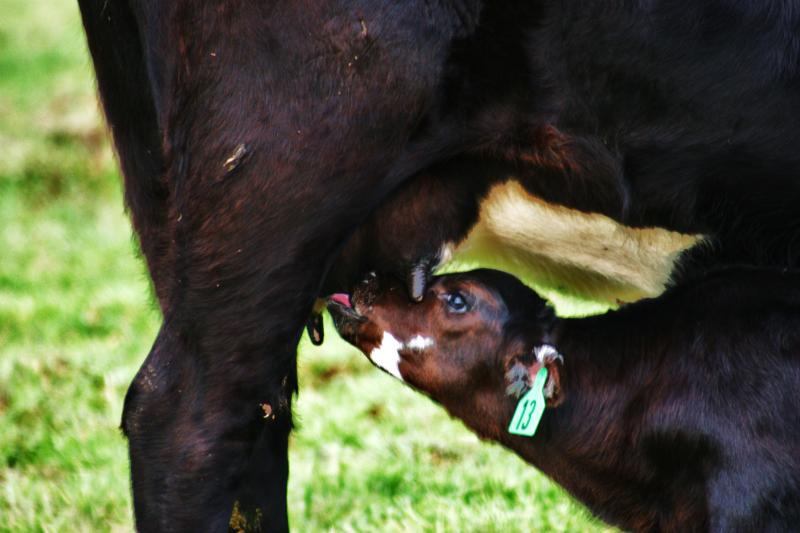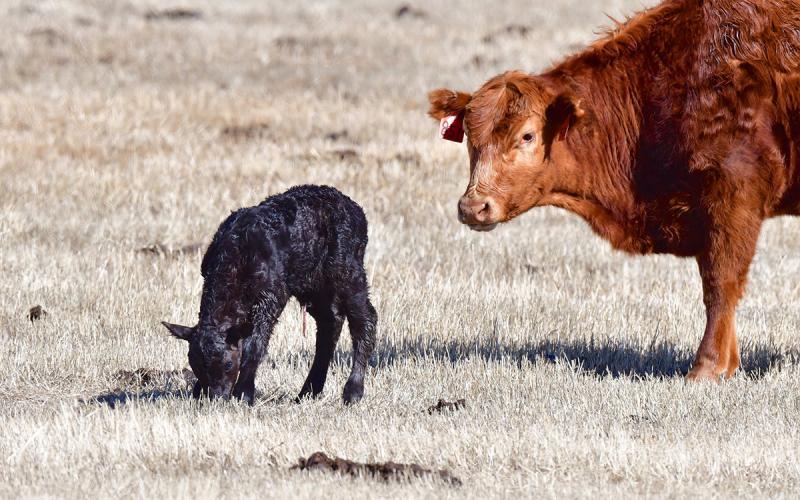This article was written by Kalyn Waters, former SDSU Extension Cow/Calf Field Specialist.
As soon as the calf hits the ground, the reproductive clock of the cow starts to tick. In order to maintain the annual production cycle of the cowherd, cows and heifers must overcome postpartum anestrus within 83 days of calving. While nutrition, body condition score (BCS), and management all play a role in the length of the postpartum interval, the suckling effect is the major limiting factor.
In order to understand the suckling effect, one must first establish the difference between the suckling effect and lactation stress. Following calving the nutritional requirements of the cow will be the highest of all production phases. This is in part due to the energy, fat, proteins, and other nutrients needed to produce milk. However, this increase in nutritional requirements is not the factor halting the resumption of normal estrous cycles in the cowherd (if the maintenance requirements of the cow are being met).
The resumption of cyclicity is dependent on Luteinizing Hormone (LH) accumulation and then subsequent secretion after calving. As the number of days following calving increase, so does the amount of LH that is being released. A total of 73% of the difference in LH secretion can be accounted for by the number of days since the cow calved, with secretion increasing as the days from calving increase. By 3 to 4 weeks, postpartum LH stores are replenished, yet LH secretions remain suboptimal to promote ovulation. Research has shown this is due to the suckling effect.
About The Suckling Effect

The suckling effect is the physical stimulation of suckling that causes the release of endogenous opioids, such as endorphins, resulting in an inhibition of LH release. These opioids work as neurotransmitters throughout the central nervous system, including the portion of the brain that is responsible for the secretion of LH, and other reproductive hormones. The physical sucking of the calf causes the release of these opioids which act on the hormone releasing portion of the brain, causing an inhibition of reproductive hormones.
The suckling effect is nothing new. In 1927 scientists began to observe that suckled cows had longer postpartum intervals than those whose calves had been removed. This spurred a tremendous amount of research in the last century, which unveiled the physiological responses for this observation. In a research trial completed in 1993 by Viker and others, it was shown that when the cow was mastectomized (removal of the udder) and the calf was allowed to suckle the flank of the cow where the udder typically would have been intact, the number of days postpartum until the cow starts to cycle was similar to that of a lactating, udder-intact cow. This trial, along with others, showed that even when the factor of lactation was removed, the suckling of the calf would still cause the release of opioids, and prolong the postpartum anestrus period.
While data has shown that temporary calf removal for 48 hours prior to breeding will allow LH secretions to increase, in many management scenarios this is not a logical option. If cows or first-calf heifers are thin or stressed, this however may be a viable option. The suckling effect is difficult to manage, however something that must be considered.
There are several factors that contribute to the length of the postpartum interval. By ensuring that cows calve in a good BCS and have adequate nutrition following calving and by working to reduce things such as calving difficulties, we are able to help the females in our herd overcome the suckling effect and maintain a 365-day calving interval.
Definitions of Bold Terms:
- Postpartum Anestrous: Period following calving that females are not experience estrous cycles.
- Postpartum Interval (PPI): Time period from calving to conception.
- Luteinizing Hormone (LH): Pulsatory hormone that stimulates follicle growth, and ultimately is released in a surge to cause ovulation.
- Suckling Effect: The physical stimulation of suckling that causes the release of endogenous opioids, such as endorphins, resulting in an inhibition of LH release, prolonging the postpartum interval.
- Lactation Stress: The nutritional stress of milk production experience by the cow following calving.
- Temporary Calf Removal: The calf is removed for 48 to 72 hours prior to the beginning of breeding. Following this timeframe the calf is returned to the cow. This is not weaning.


